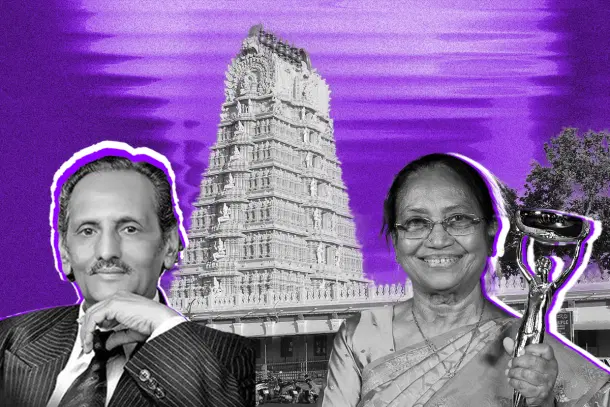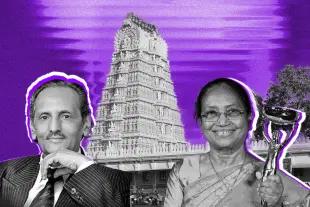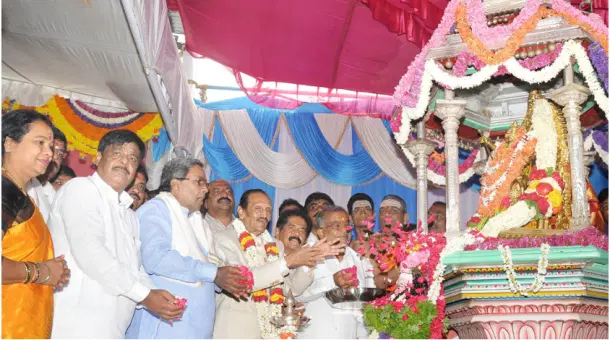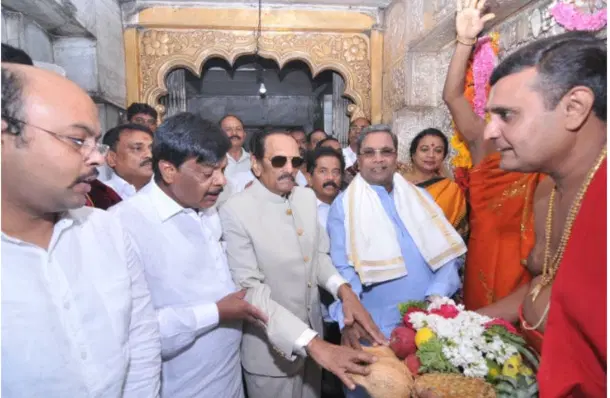Culture
The Two Poets: One Wins a Booker Prize, The Other Wins a Community's Heart. A Dasara Tale
Deviyani G
Aug 30, 2025, 08:58 AM | Updated Oct 09, 2025, 09:00 AM IST
Save & read from anywhere!
Bookmark stories for easy access on any device or the Swarajya app.


The backlash was swift, merciless, and entirely predictable.
When Banu Mushtaq's Dasara invitation triggered statewide fury, it was not because Karnataka had suddenly discovered religious intolerance.
It was because the state finally confronted the difference between someone who loves their culture enough to embrace it completely and someone who stands apart, forever analysing, forever criticising, forever claiming victimhood for their chosen exile.
Her critics pointed to inflammatory remarks she had delivered at the Janasahitya Sammelan in Hassan in 2023, where she had declared it “ironic that the Kannada language was given the form of a mother named Bhuvaneshwari and the flag was made using the same colours of turmeric and saffron that Hindus use for auspicious events.”
She had gone further, alleging that “by creating such colours and Bhuvaneshwari, a conspiracy was hatched to keep minorities away from Kannada service.”
The backlash was unforgiving.
Former MP Pratap Simha posed the question that cut to the bone: “Banu Mushtaq, who did not accept Bhuvaneshwari, presiding deity of this state, will she be able to accept Devi Chamundeswari, will she be able to take the aarthi, will she commit idolatry and worship? Will her religion not interfere in such practice? Why does turmeric and saffron bother her? Are they not part of Kannada culture?”
The logic was devastating in its simplicity. Someone who could not respect Bhuvaneshwari, the personification of the very state she claimed to represent, how could she be expected to have genuine devotion toward Chamundeshwari, whose divine presence must be honoured through prayer and the ritual showering of flowers that forms the sacred heart of Dasara's Hindu festival inauguration?
When the Dasara invitation controversy erupted, Mushtaq herself invoked the very precedent that would expose her philosophical contradiction: “When Nisar Ahmed inaugurated the festival, no objections were raised then. Such disputes should not be created now.”
The irony was breathtaking. In defending her right to inaugurate Dasara, she pointed to the very man whose approach to Karnataka's cultural symbols was diametrically opposite to hers. Just seven years earlier, that same festival had witnessed a strikingly different scene.
Nadoja Padma Shri K.S. Nissar Ahmed had stood atop the Chamundi Hill, “showering flower petals on the idol of Goddess Chamundeshwari, the reigning deity of Mysuru.” There was no controversy, no protests, no questions about his religious credentials or right to be there. The community had embraced him with complete acceptance.


The Central Contradiction
While Mushtaq attacked the personification of language and land as goddess, Nissar Ahmed's most beloved creation, the anthem Nityotsava, did precisely the opposite.
His poem treated “entire Karnataka as divine feminine entity worthy of worship,” celebrating the land as Kannada Maathe (Mother) in verses that declared: Salutation to Kannada Maathe daily. It is eternal, Nitya Utsava. Nitya means daily, every day. It is Shashvata and Chira—permanent and eternal.
Kokkare Hosahalli Sheikh Haider Nissar Ahmed embodied what seemed impossible in contemporary identity politics. He was a Muslim by birth who became Hindu by practice, yet remained authentically both. This was no academic exercise in pluralism but lived reality expressed through decades of genuine spiritual seeking.
This author has witnessed first hand his temple visits across Mysore after the Dasara inauguration. They were not calculated gestures designed for public consumption but expressions of profound devotional practice. Regular darshans, participating in aarti with evident reverence, and his encyclopaedic knowledge of Hindu classical texts revealed a man who had dissolved boundaries others treated as impermeable walls.
“His knowledge about Hindu and Islamic classical texts is deep. He can talk about any incident from Ramayana, Mahabharata, Gita and the rest of Hindu religious texts,” observed those who witnessed his scholarship.
When questioned about being the first Muslim to inaugurate Dasara, his response cut through the noise with philosophical clarity: “This question is irrelevant. I feel nice. Only when you understand another religion do you really understand your own religion. Unless you have respect and sympathy for other religions, you will not be able to like your own religion,” he told the local evening daily Star of Mysore in 2017.
His devotional versatility defied every attempt at religious categorisation. Few realised that “the famous song on Krishna Benne Kadda Namma Krishna Benne Kadda (the thief who stole butter, our Krishna) is written by Nissar Ahmed”—a testament to how completely this Muslim poet had absorbed, internalised, and elevated the devotional traditions of his cultural homeland.
The depth of his integration into Hindu spiritual life was perhaps most powerfully demonstrated when Suttur Seer Sri Shivarathri Deshikendra Swamiji graced the occasion of the release of Seemateetana Sirivanta Suggi, a collection of selected poems by Padma Shri, Nadoja Prof. K.S. Nissar Ahmed.
The presence of this revered Lingayat spiritual leader at a Muslim poet's book launch was no mere courtesy but recognition of authentic spiritual kinship that transcended religious labels.
Now compare all this to the reaction that Banu Mushtaq has been getting on the suggestion that she inaugurate the Dasara festivities.
Mushtaq wants to use the example of Nissar Ahmed but without the reverence or respect he showed for the gods.
She has questioned not merely the personification of Kannada as Bhuvaneshwari but attacked the very colours chosen for the Karnataka flag—“the same colours of turmeric and saffron that Hindus use for auspicious events.” Her analysis suggested systematic exclusion, that these symbols were deliberately designed as “a conspiracy to keep minorities away from Kannada service.”
What Mushtaq dismisses as conspiracy represents the very heart of Karnataka's Hindu cultural identity.
The personification of Kannada as Bhuvaneshwari, literally “the goddess of the universe,” and the adoption of the red and yellow flag emerged from the profound Hindu spiritual tradition that sees the divine feminine as the organising principle of existence itself.
When Karnataka chose this form to represent their language and land, they were asserting something fundamental. They declared that this territory is sacred space, protected by and dedicated to the divine mother herself.
During Karnataka's unification struggle, these Hindu symbols became the emotional rallying points that gave spiritual meaning to political action. The Ekikarana (unification) movement was fundamentally about asserting cultural identity across artificial administrative boundaries imposed by foreign rule.
When activists across different regions saw the red and yellow banner, they recognised the sacred Hindu symbols that connected them to their dharmic identity. This was not arbitrary cultural construction but the assertion of eternal truth—that this land is sacred, that its language flows from divine source, that its culture is rooted in the dharmic tradition that precedes and transcends all political arrangements.
The personification of Karnataka as divine mother represents one of the most profound themes in Kannada literature, reaching its pinnacle in the work of Kuvempu, the legendary poet laureate whose vision shaped modern Karnataka's cultural consciousness.
Kuvempu's masterpiece, which became Karnataka's official state anthem, does precisely what Mushtaq condemns. It personifies both Karnataka and Mother India as divine feminine entities. The anthem celebrates Karnataka as the beloved daughter of Mother India.
This double personification—Karnataka as daughter-goddess, India as cosmic mother—represents the sophisticated theological framework that Mushtaq dismisses as exclusionary conspiracy.
This is not some provincial Karnataka innovation but draws from the deepest wellsprings of Indian cultural consciousness. The personification of India as divine mother found its most iconic expression in Bankim Chandra Chatterjee's immortal Vande Mataram, which literally means “I bow to thee, Mother.” Bankim's vision of Mother India as goddess demanding devotion from her children became the spiritual foundation of Indian nationalism itself.
Abanindranath Tagore's legendary painting Bharat Mata gave visual form to this same conception—India as serene, saffron-robed goddess holding the offerings of rice, cloth, and prayer beads, embodying both spiritual authority and maternal compassion. This image became so powerful that it shaped how generations of Indians understood their relationship to their homeland.
What Mushtaq failed to comprehend is that such personification represents not Hindu exclusivity but a universal human tendency to understand homeland through maternal metaphor. Across cultures and civilisations, peoples have instinctively personified their lands as feminine entities deserving filial devotion.
Britannia stands as perhaps the most famous example, the personification of Britain as a helmeted goddess bearing trident and shield, embodying the maritime power and imperial majesty of the British Isles. For centuries, Britons sang of their land as maternal figure worthy of sacrifice and devotion.
Similarly, France has Marianne, the embodiment of French revolutionary ideals and national identity as feminine figure. Germania represents the German lands, while Columbia once personified America. Russia has Mother Russia, and countless other nations have found in feminine personification the most natural way to express the intimate relationship between people and place.
This universal pattern reveals something profound about human psychology. The instinctive understanding that our relationship to homeland mirrors our most primal relationship, that between child and mother. To attack this personification as conspiracy, as Mushtaq did, is to assault not merely Hindu tradition but a fundamental aspect of human cultural expression that transcends religious and cultural boundaries.
Where Nissar Ahmed embraced with his entire being, Mushtaq questioned with her analytical mind. Where he participated as devoted practitioner, she critiqued as detached observer. Where he found divine presence worthy of worship, she detected political conspiracy requiring exposure.
The contrast in community responses revealed something profound about how societies distinguish between authentic engagement and performative criticism. Human communities, like individual humans, possess an almost supernatural ability to detect the difference between genuine love and calculated positioning.
Even the counter-proposal spoke volumes about collective wisdom: “MP Yaduveer said that instead of Banu Mushtaq, Deepa Basti, who was responsible for Banu winning the Booker Prize, should be invited to inaugurate the Dasara.”
The message was unmistakable. The community would rather honour someone who had facilitated literary achievement than the laureate herself, if that laureate was perceived as standing against rather than with Karnataka's cultural essence.
This was not religious prejudice but something more fundamental, the instinctive rejection of those who claim belonging while simultaneously rejecting the very foundations of that belonging.
Confronted with mounting criticism, Mushtaq attempted damage control: “What I said in Hassan in 2023 has been distorted. What I said is different, what is reported in the media is different. I respect Nadahabba. Dussehra is my favourite festival. I remember watching Mysore Dussehra with my father when I was young. I have said that I respect Nadahabba and my mother Chamundeshwari.”
But communities, like individuals, respond to the authenticity they sense beneath strategic communications. Where they had felt genuine devotion from Nissar Ahmed flowing through decades of consistent practice, they detected calculated repositioning from Mushtaq following a public relations disaster.
The attempted clarification only deepened the contradiction. How does one simultaneously respect “mother Chamundeshwari” while condemning the cultural framework that produces such personification as conspiracy against minorities?





